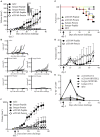Comparison of Protein and Peptide Targeting for the Development of a CD169-Based Vaccination Strategy Against Melanoma
- PMID: 30237798
- PMCID: PMC6135888
- DOI: 10.3389/fimmu.2018.01997
Comparison of Protein and Peptide Targeting for the Development of a CD169-Based Vaccination Strategy Against Melanoma
Abstract
CD169+ macrophages are part of the innate immune system and capture pathogens that enter secondary lymphoid organs such as the spleen and the lymph nodes. Their strategic location in the marginal zone of the spleen and the subcapsular sinus in the lymph node enables them to capture antigens from the blood and the lymph respectively. Interestingly, these specific CD169+ macrophages do not destroy the antigens they obtain, but instead, transfer it to B cells and dendritic cells (DCs) which facilitates the induction of strong adaptive immune responses. This latter characteristic of the CD169+ macrophages can be exploited by specifically targeting tumor antigens to CD169+ macrophages for the induction of specific T cell immunity. In the current study we target protein and peptide antigen as antibody-antigen conjugates to CD169+ macrophages. We monitored the primary, memory, and recall T cell responses and evaluated the anti-tumor immune responses after immunization. In conclusion, both protein and peptide targeting to CD169 resulted in strong primary, memory, and recall T cell responses and protective immunity against melanoma, which indicates that both forms of antigen can be further explored as anti-cancer vaccination strategy.
Keywords: CD169; Siglec-1; T cell; antigen; cross-presentation; macrophage; sialoadhesin; tumor immunology.
Figures




Similar articles
-
CD169+ Macrophages Capture and Dendritic Cells Instruct: The Interplay of the Gatekeeper and the General of the Immune System.Front Immunol. 2018 Oct 26;9:2472. doi: 10.3389/fimmu.2018.02472. eCollection 2018. Front Immunol. 2018. PMID: 30416504 Free PMC article. Review.
-
Possible functions of CD169-positive sinus macrophages in lymph nodes in anti-tumor immune responses.Cancer Sci. 2017 Mar;108(3):290-295. doi: 10.1111/cas.13137. Epub 2017 Mar 7. Cancer Sci. 2017. PMID: 28002629 Free PMC article. Review.
-
Functional CD169 on Macrophages Mediates Interaction with Dendritic Cells for CD8+ T Cell Cross-Priming.Cell Rep. 2018 Feb 6;22(6):1484-1495. doi: 10.1016/j.celrep.2018.01.021. Cell Rep. 2018. PMID: 29425504
-
Selective tumor antigen vaccine delivery to human CD169+ antigen-presenting cells using ganglioside-liposomes.Proc Natl Acad Sci U S A. 2020 Nov 3;117(44):27528-27539. doi: 10.1073/pnas.2006186117. Epub 2020 Oct 16. Proc Natl Acad Sci U S A. 2020. PMID: 33067394 Free PMC article.
-
CD169 mediates the capture of exosomes in spleen and lymph node.Blood. 2014 Jan 9;123(2):208-16. doi: 10.1182/blood-2013-03-489732. Epub 2013 Nov 19. Blood. 2014. PMID: 24255917 Free PMC article.
Cited by
-
STING-activating dendritic cell-targeted nanovaccines that evoke potent antigen cross-presentation for cancer immunotherapy.Bioact Mater. 2024 Sep 6;42:345-365. doi: 10.1016/j.bioactmat.2024.09.002. eCollection 2024 Dec. Bioact Mater. 2024. PMID: 39290338 Free PMC article.
-
Immunomodulatory Responses of Subcapsular Sinus Floor Lymphatic Endothelial Cells in Tumor-Draining Lymph Nodes.Cancers (Basel). 2022 Jul 24;14(15):3602. doi: 10.3390/cancers14153602. Cancers (Basel). 2022. PMID: 35892863 Free PMC article.
-
Cell-targeted vaccines: implications for adaptive immunity.Front Immunol. 2023 Aug 16;14:1221008. doi: 10.3389/fimmu.2023.1221008. eCollection 2023. Front Immunol. 2023. PMID: 37662903 Free PMC article. Review.
-
Activation of CD8⁺ T Cell Responses after Melanoma Antigen Targeting to CD169⁺ Antigen Presenting Cells in Mice and Humans.Cancers (Basel). 2019 Feb 5;11(2):183. doi: 10.3390/cancers11020183. Cancers (Basel). 2019. PMID: 30764534 Free PMC article.
-
Functions of CD169 positive macrophages in human diseases (Review).Biomed Rep. 2021 Feb;14(2):26. doi: 10.3892/br.2020.1402. Epub 2020 Dec 17. Biomed Rep. 2021. PMID: 33408860 Free PMC article. Review.
References
Publication types
MeSH terms
Substances
LinkOut - more resources
Full Text Sources
Other Literature Sources
Medical

